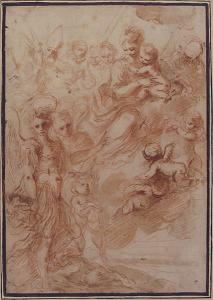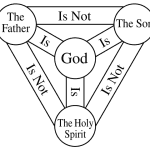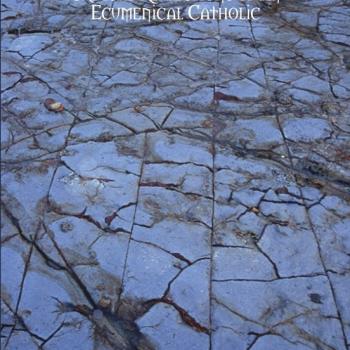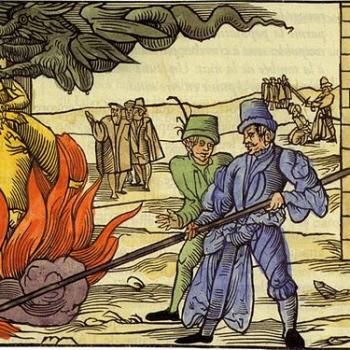11. “Second Death” = “Lake of Fire” = Eternal Torment in Hell. Jesus & Luke Believed in Both Hades and Hell
Lucas Banzoli is a very active Brazilian anti-Catholic polemicist, who holds to basically a Seventh-Day Adventist theology, whereby there is no such thing as a soul that consciously exists outside of a body, and no hell (soul sleep and annihilationism). This leads him to a Christology which is deficient and heterodox in terms of Christ’s human nature after His death. He has a Master’s degree in theology, a degree and postgraduate work in history, a license in letters, and is a history teacher, author of 25 books, as well as blogmaster (but now inactive) for six blogs. He’s active on YouTube.
This is my 47th refutation of Banzoli’s writings. From 5-25-22 until 11-12-22 (almost half a year) he didn’t write even one single word in reply. Since then he has mustered up the courage to counter-respond three times. Why so few and so late? Well, he says it’s because my articles are “without exception poor, superficial and weak.” Indeed, he thinks my writings are so bad that “only a severely cognitively impaired person would be inclined to take” them “seriously.” He didn’t “waste time reading” 37 of my first 40 replies (three articles being his proof of the worthlessness of all of my 4,000+ articles and 51 books). He also denied that I had a “job” and claimed that I didn’t “work.” Despite all this, Banzoli concluded that replying to me is so “entertaining” that he resolved to “make a point of rebutting” my articles “one by one.” I quickly disposed of his relentlessly false, ridiculous, and boorish personal insults and attacks in Facebook posts dated 11-13-22 and 11-15-22 and 11-23-22.
My current effort is a major multi-part response to Banzoli’s 1900-page self-published book, The Legend of the Immortality of the Soul [A Lenda da Imortalidade da Alma], published on 1 August 2022. He claims to have “cover[ed] in depth all the immortalist arguments” and to have “present[ed] all the biblical proofs of the death of the soul . . .” and he confidently asserted: “the immortality of the soul is at the root of almost all destructive deception and false religion.” He himself admits on page 18 of his Introduction that what he is opposing is held by “nearly all the Christians in the world.” A sincere unbiblical error (and I assume his sincerity) is no less dangerous than a deliberate lie, and we apologists will be “judged with greater strictness” for any false teachings that we spread (Jas 3:1).
I use RSV for the Bible passages (including ones that Banzoli cites) unless otherwise indicated. Google Translate is utilized to render Lucas’ Portugese into English. Occasionally I slightly modify clearly inadequate translations, so that his words will read more smoothly and meaningfully in English. His words will be in blue.
*****
See the other installments:
See also the related articles:
Seven Replies Re Interceding Saints (vs. Lucas Banzoli) [5-25-22]
Answer to Banzoli’s “Challenge” Re Intercession of Saints [9-20-22]
Bible on Praying Straight to God (vs. Lucas Banzoli) [9-21-22]
Reply to Banzoli’s “Analyzing the ‘evidence’ of saints’ intercession” [9-22-22]
*****
[T]he Bible teaches that the wicked will die not only in this life, but also in the next, after the resurrection. There are two deaths for the wicked, but only one for the righteous (the one we suffer at the end of this life). While the righteous are raised to eternal life, the wicked who resurrect die forever, . . .
Revelation 20:6 Blessed and holy is he who shares in the first resurrection! Over such the second death has no power, . . .
. . . there is also another death, the second, which takes place after the resurrection: to which only the damned are subject. Men are capable of killing someone in this life (the first death), but only God can do the same in the other (the second death). (pp. 282-283)
Alright. Let’s take his hypothesis (that God annihilates the wicked, rather than torment them in a fiery hell forever) and subject it to the appropriate cross-referencing that Banzoli didn’t do here. How does the Bible describe the “second death”?:
Revelation 20:14-15 Then Death and Hades were thrown into the lake of fire. This is the second death, the lake of fire; [15] and if any one’s name was not found written in the book of life, he was thrown into the lake of fire.
Revelation 21:8 “But as for the cowardly, the faithless, the polluted, as for murderers, fornicators, sorcerers, idolaters, and all liars, their lot shall be in the lake that burns with fire and sulphur, which is the second death.” (cf. 2:11)
As we see, the “second death”: means being “thrown into” the “lake of fire.” So what else can we find about about this horrific “lake”? Does it represent and cause annihilation or eternal conscious torment?:
Revelation 19:20 And the beast was captured, and with it the false prophet who in its presence had worked the signs by which he deceived those who had received the mark of the beast and those who worshiped its image. These two were thrown alive into the lake of fire that burns with sulphur.
Revelation 20:10 and the devil who had deceived them was thrown into the lake of fire and sulphur where the beast and the false prophet were, and they will be tormented day and night for ever and ever.
Revelation 20:10 puts it all together. The Lake of Fire is conscious eternal torment in hell, not annihilation. I’m sure Banzoli will come up with some claptrap later in his book, to attempt to explain away this irrefutable passage. I will dispose of that when I get to it. But it clearly makes no sense to interpret 20:10 as “they will be annihilated day and night for ever and ever.”
The words chosen frighteningly describe indefinite duration of the torment and its ongoing nature. If “annihilation” were the intended meaning, the verse would almost certainly read something like: “and the devil who had deceived them was thrown into the lake of fire and sulphur where the beast and the false prophet were, and they were annihilated and no longer existed at all.” But unfortunately for Banzoli and his heretical buddies, who deny that Jesus is God, the passage does not read that way.
Jesus reflects this thought in saying:
Mark 9:43, 45, 47-48 And if your hand causes you to sin, cut it off; it is better for you to enter life maimed than with two hands to go to hell, to the unquenchable fire. [45] And if your foot causes you to sin, cut it off; it is better for you to enter life lame than with two feet to be thrown into hell. [47] And if your eye causes you to sin, pluck it out; it is better for you to enter the kingdom of God with one eye than with two eyes to be thrown into hell, [48] where their worm does not die, and the fire is not quenched.
Jesus appears to be citing Isaiah 66:24 and making a parallel of the first and second deaths:
Isaiah 66:24 “And they shall go forth and look on the dead bodies of the men that have rebelled against me; for their worm shall not die, their fire shall not be quenched, and they shall be an abhorrence to all flesh.”
Barnes’ Notes on the Bible [for Mark 9:48]:
Their worm – This figure is taken from Isaiah 66:24. See the notes at that passage. In describing the great prosperity. of the kingdom of the Messiah, Isaiah says that the people of God “shall go forth, and look upon the carcasses of the men who have transgressed against God.” Their enemies would be overcome. They would be slain. The people of God would triumph. The figure is taken from heaps of the dead slain in battle; and the prophet says that the number would be so great that their worm – the worm feeding on the dead – would not die, would live long – as long as there were carcasses to be devoured; and that the fire which was used to burn the bodies of the dead would continue long to burn, and would not be extinguished until they were consumed. The figure, therefore, denotes great misery, and certain and terrible destruction. In these verses it is applied to the state beyond the grave, and is intended to denote that the destruction of the wicked will be awful, widespread, and eternal.
It is not to be supposed that there will be any “real” worm in hell – perhaps no material fire; nor can it be told what was particularly intended by the undying worm. There is no authority for applying it, as is often done, to remorse of conscience, anymore than to any other of the pains and reflections of hell. It is a mere image of loathsome, dreadful, and “eternal” suffering. In what that suffering will consist it is probably beyond the power of any living mortal to imagine. The word their, in the phrase “their worm,” is used merely to keep up the “image” or “figure.” Dead bodies putrefying in that valley would be overrun with worms, while the “fire” would not be confined to them, but would spread to other objects kindled by combustibles through all the valley.
And of course, we have this very plain passage from Jesus, too:
Matthew 25:41, 46 Then he will say to those at his left hand, “Depart from me, you cursed, into the eternal fire prepared for the devil and his angels; . . .” [46] And they will go away into eternal punishment, but the righteous into eternal life.
[I]t is as if Luke [in 12:4-5] completely ignored the supposed intermediate state between death and resurrection, since after physical death there is no mention of Hades (the intermediate state), but only Gehenna: the final state. This not only indicates the non-existence of an intermediate conscious state between death and resurrection in which the soul outside the body is supposedly released after death, but also refutes any pretense of taking the words of Jesus in the sense of an endorsement of soul survival. If that had been the intention, the presence of Hades would have been essential, as the place where the soul is thrown after physical death, which would be its natural and immediate destiny outside the body. Rather, what follows the death of the body is the casting of the whole person into Gehenna, which reinforces the biblical notion that there is no event between death and resurrection from the perspective of the one who dies. (p. 289)
This is nonsense. Jesus was simply not talking about Hades in Luke 12, but rather, hell (Gehenna). It’s two different things. We know that Jesus and Luke (who recorded his words) both believed in Hades as well, from Luke 10:15 (“And you, Caper’na-um, will you be exalted to heaven? You shall be brought down to Hades.”) and Luke 16:23 (“and in Hades, being in torment, he lifted up his eyes, and saw Abraham far off and Laz’arus in his bosom”).
Moreover, Luke, who wrote the Book of Acts, too, cited Peter, who in turn cited David in the Old Testament, referring to Sheol (translated as Hades in the NT: Acts 2:27, 31). Orthodox Christians (of whom Banzoli is not!) believe that Sheol/Hades was the intermediate state where all souls went before the death of Christ on the cross, and believe that heaven or hell will be the ultimate, endless destiny of all souls: good or bad, respectively.
As we see above, Jesus and Luke believed in both things. Jesus was simply talking about hell in Luke 12. It doesn’t logically follow that He therefore denied the existence of Hades, and we know for a fact that He didn’t, from other passages. Aren’t cross-referencing and systematic theology great? Banzoli might benefit from realizing that both exist and are very helpful: especially against heresies like his.
St. Paul also believed in Hades, as we know from his reference to those “under the earth” (Phil 2:10) and when he wrote that Jesus “descended into the lower parts of the earth” (Eph 4:9) to liberate “a host of captives” from Hades (4:8). Peter, likewise, notes that Jesus — “alive in the spirit” — after being “being put to death in the flesh” went and “preached to the spirits in prison”; that is, in Sheol/Hades (1 Pet 3:18-19).
***
Practical Matters: Perhaps some of my 4,000+ free online articles (the most comprehensive “one-stop” Catholic apologetics site) or fifty books have helped you (by God’s grace) to decide to become Catholic or to return to the Church, or better understand some doctrines and why we believe them.
Or you may believe my work is worthy to support for the purpose of apologetics and evangelism in general. If so, please seriously consider a much-needed financial contribution. I’m always in need of more funds: especially monthly support. “The laborer is worthy of his wages” (1 Tim 5:18, NKJV). 1 December 2021 was my 20th anniversary as a full-time Catholic apologist, and February 2022 marked the 25th anniversary of my blog.
PayPal donations are the easiest: just send to my email address: [email protected]. You’ll see the term “Catholic Used Book Service”, which is my old side-business. To learn about the different methods of contributing, including 100% tax deduction, etc., see my page: About Catholic Apologist Dave Armstrong / Donation Information. Thanks a million from the bottom of my heart!
***
Photo credit: Saint Michael the Archangel and Another Figure Recommending a Soul to the Virgin and Child in Heaven, by Bartolomeo Biscaino (1629-1657) [public domain / Wikimedia Commons]
***
Summary: Part 11 of many responses to Lucas Banzoli’s 1900-page book, The Legend of the Immortality of the Soul: published on 1 August 2022. I defend historic Christianity.














